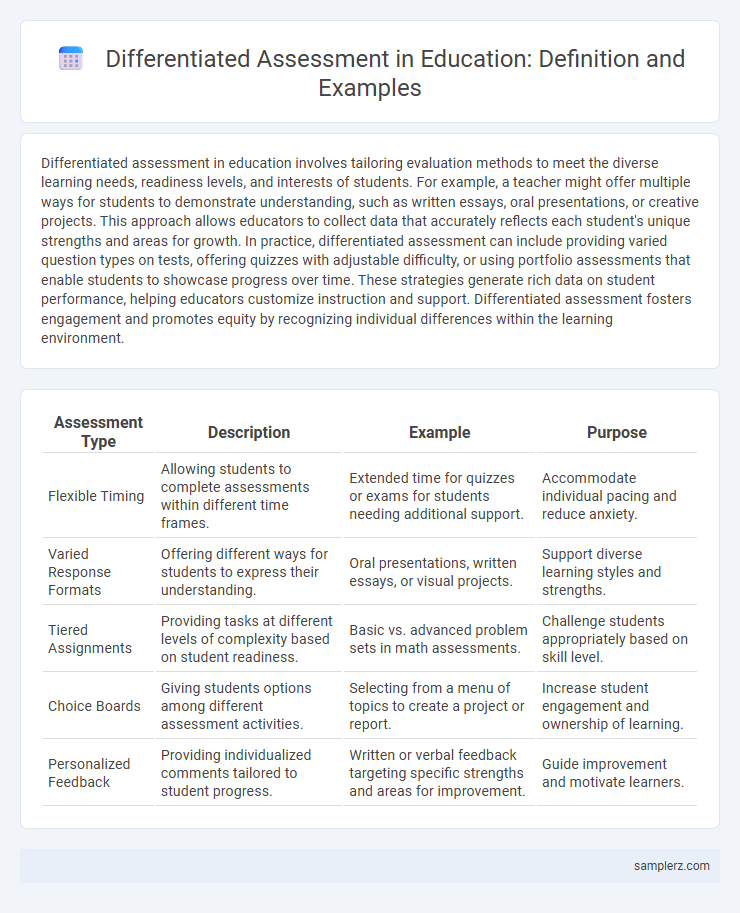Differentiated assessment in education involves tailoring evaluation methods to meet the diverse learning needs, readiness levels, and interests of students. For example, a teacher might offer multiple ways for students to demonstrate understanding, such as written essays, oral presentations, or creative projects. This approach allows educators to collect data that accurately reflects each student's unique strengths and areas for growth. In practice, differentiated assessment can include providing varied question types on tests, offering quizzes with adjustable difficulty, or using portfolio assessments that enable students to showcase progress over time. These strategies generate rich data on student performance, helping educators customize instruction and support. Differentiated assessment fosters engagement and promotes equity by recognizing individual differences within the learning environment.
Table of Comparison
| Assessment Type | Description | Example | Purpose |
|---|---|---|---|
| Flexible Timing | Allowing students to complete assessments within different time frames. | Extended time for quizzes or exams for students needing additional support. | Accommodate individual pacing and reduce anxiety. |
| Varied Response Formats | Offering different ways for students to express their understanding. | Oral presentations, written essays, or visual projects. | Support diverse learning styles and strengths. |
| Tiered Assignments | Providing tasks at different levels of complexity based on student readiness. | Basic vs. advanced problem sets in math assessments. | Challenge students appropriately based on skill level. |
| Choice Boards | Giving students options among different assessment activities. | Selecting from a menu of topics to create a project or report. | Increase student engagement and ownership of learning. |
| Personalized Feedback | Providing individualized comments tailored to student progress. | Written or verbal feedback targeting specific strengths and areas for improvement. | Guide improvement and motivate learners. |
Understanding Differentiated Assessment in Education
Differentiated assessment in education involves tailoring evaluation methods to accommodate diverse student learning styles and abilities, such as offering varied test formats like multiple-choice, essays, or oral presentations. This approach enhances student engagement by allowing learners to demonstrate understanding through their strengths, promoting more accurate measurement of individual progress. Implementing ongoing formative assessments further supports personalized feedback, guiding instruction to meet each student's specific needs.
Types of Differentiated Assessment Strategies
Differentiated assessment strategies include formative assessments such as exit tickets and quizzes tailored to varied learning styles, performance-based tasks like presentations or projects that allow students to demonstrate understanding in diverse ways, and tiered assignments designed at varying levels of difficulty to meet individual readiness. Using technology-based assessments enables personalized feedback and adaptive challenges, enhancing student engagement and learning outcomes. These methods collectively support a more inclusive and effective evaluation of student progress across diverse abilities.
Formative Assessment: Tailoring Feedback for Student Needs
Formative assessment techniques such as exit tickets, peer reviews, and targeted questioning enable educators to tailor feedback according to individual student needs, promoting personalized learning pathways. By continuously monitoring progress, teachers can adjust instruction and provide specific guidance that addresses diverse learning styles and skill levels. Data from these assessments help identify gaps in understanding, allowing for timely intervention and support.
Differentiated Summative Assessments: Examples and Approaches
Differentiated summative assessments include project-based evaluations tailored to student interests, varied formats such as written reports, presentations, or multimedia submissions, and tiered testing that adjusts question complexity according to learners' proficiency levels. These approaches enhance engagement by accommodating diverse learning styles and readiness, providing a more accurate measure of individual student understanding. Incorporating rubrics with flexible criteria further supports personalized feedback and grading in summative contexts.
Project-Based Assessment for Diverse Learners
Project-based assessment offers diverse learners opportunities to demonstrate understanding through hands-on, real-world tasks tailored to their unique strengths and learning styles. This method emphasizes critical thinking, collaboration, and creativity, allowing students with varied abilities to engage meaningfully and showcase mastery beyond traditional testing formats. Educators can customize projects to align with individual needs, promoting equitable evaluation and deeper comprehension across diverse student populations.
Using Choice Boards to Personalize Assessment Tasks
Choice boards in assessment allow educators to tailor evaluation tasks to individual student strengths, interests, and learning preferences, enhancing engagement and motivation. These boards present a variety of options, such as written reports, creative projects, or oral presentations, enabling students to demonstrate mastery in ways that align with their unique learning styles. Implementing choice boards supports differentiated instruction by promoting autonomy and providing multiple pathways for students to showcase understanding within a personalized learning environment.
Tiered Assignments: Addressing Multiple Skill Levels
Tiered assignments in education adapt tasks to varying student skill levels, ensuring personalized learning experiences. By providing different versions of an assignment based on complexity, educators effectively engage students with diverse abilities and foster growth. This strategy enhances assessment accuracy by matching expectations to individual readiness and promotes equitable evaluation.
Leveraging Technology for Adaptive Assessments
Leveraging technology for adaptive assessments enables personalized learning experiences by adjusting question difficulty based on real-time student responses, ensuring accurate measurement of individual proficiency. Tools like AI-driven platforms analyze performance patterns to provide immediate feedback, promoting targeted skill development. This approach enhances assessment efficiency and supports diverse learner needs through customized content delivery.
Performance Tasks: Showcasing Multiple Intelligences
Performance tasks in differentiated assessment allow students to demonstrate their unique strengths across Gardner's multiple intelligences, such as creating a musical composition for musical intelligence or designing a scientific experiment for logical-mathematical intelligence. These tasks engage learners by providing varied formats that cater to individual cognitive strengths, promoting deeper understanding and retention. By showcasing skills in diverse modalities, performance tasks offer a comprehensive evaluation of student learning beyond traditional tests.
Flexible Grading Practices in Differentiated Assessment
Flexible grading practices in differentiated assessment accommodate diverse learner needs by allowing modifications in assessment criteria based on individual student abilities and progress. Examples include rubric adjustments, offering varied assignment formats, and providing alternative evaluation timelines. These practices ensure equitable measurement of student learning while promoting growth and engagement across heterogeneous classrooms.

example of differentiated in assessment Infographic
 samplerz.com
samplerz.com